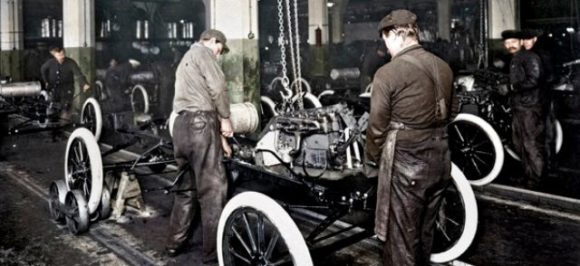 DETROIT — THE moving assembly line was the simplest of inventions, born of necessity to meet the exploding demand for automobiles in America in the early 20th century.
DETROIT — THE moving assembly line was the simplest of inventions, born of necessity to meet the exploding demand for automobiles in America in the early 20th century.
Angie Tostea on the assembly line at Ford’s plant in Wayne, Mich. The line, a legacy to the entire industry, celebrated its centennial this month.
And while it turned 100 years old this month, “the line” remains as integral to the progress of the auto industry as it was in the days of Henry Ford.
The assembly line is a constantly evolving industrial ballet of workers and robots building cars. And automakers like the Ford Motor Company are finding that building multiple models on the same line is a huge key to success in the intensely competitive global marketplace.
Updating the assembly line is a big part of the “One Ford” corporate strategy that has helped the nation’s second-biggest automaker lead the recent recovery of the American auto industry.
“There are probably very few inventions in the auto industry that started 100 years ago and are still here today,” said John Fleming, Ford’s executive vice president for global manufacturing.
So much has changed in the industry since Mr. Ford installed the first, rudimentary assembly line at his company’s Model T plant in Highland Park, Mich., in October 1913.
But automakers around the world use essentially the same basic method of mass production, turning a bare automotive chassis at one end of the line into a finished car at the other.
In the beginning, the line was a critical step toward ensuring that the same processes were repeated over and over to manufacture one specific model of the highest quality. Now, the modern assembly line produces a wide variety of vehicles that are virtually custom-built at a moment’s notice for customers in far-flung markets.
“You are always asking how you best organize the work inside a vehicle plant to be most efficient,” Mr. Fleming said.
To achieve efficiency, Ford has dropped extraneous divisions (Mercury), sold off luxury brands (Volvo, Jaguar and Land Rover), and streamlined its product lineup. By doing so, it can concentrate on building cars like the Fiesta subcompact and Focus sedan at factories in North America, South America, Asia and Europe for customers in each of those regions.
But those best-selling models could not succeed without assembly plants that use the same techniques, whether in the United States, Germany, China or elsewhere.
Ford is in the midst of one of its largest expansion programs, with factories going up in China, India, Russia and Thailand. The foundation of the plan is its continuous effort to innovate and improve the humble assembly line, and replicate it in diverse, growing markets.
The company’s advanced manufacturing technologies include lower-cost, faster stamping processes that reduce the time it takes to produce sheet-metal parts. It also uses three-dimensional drawings to create prototypes of components that can be tested in days rather than months.
On the line, new robotic systems used in the final assembly process can detect even the tiniest specks of dirt and prevent imperfections in paint that mar the surface of a sparkling new car.
The advances are a testament to the automaker’s relentless drive to manufacture better cars — and a reminder that one of Henry Ford’s favorite sayings still applies in today’s world. “Nothing is particularly hard,” he said, “if you divide it into small jobs.”
The first moving assembly line was a primitive — and ingenious — way to speed up production and cut costs.
Ford’s engineers created a system in the Highland Park plant in which a chassis was pulled by a winch and a rope stretched across the factory floor. Stationed along the 150-foot-long line were about 140 workers, each of whom added particular parts to the vehicle.
The Model T’s 3,000 parts were assembled in 84 distinct steps, all made possible by the line. The process reduced the time needed to assemble a car from 12 hours to fewer than three. Other functions in the plant were improved and accelerated to keep up with the new, quicker pace of production.
“Along with the line came overhead conveyors to move parts, wheel-painting machines and many other labor-saving innovations,” said Bob Casey, former curator of transportation at the Henry Ford Museum and author of “The Model T: A Centennial History.”
The assembly line became a working laboratory that Ford engineers constantly tinkered with. Other auto companies followed suit and adapted their own versions of the line. Soon, competition became the driving force to improve production.
“Automakers never stopped seeking ways to make this old technology better,” Mr. Casey said.
